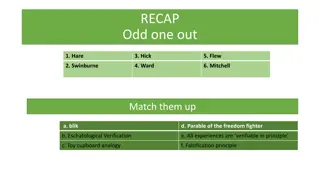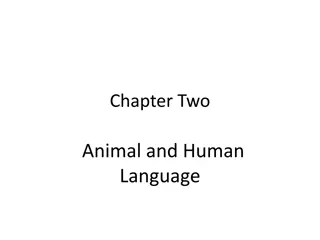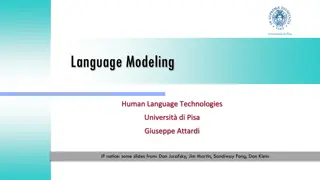Understanding the Distinctive Features of Human Language
Human language possesses distinctive features such as the use of sound signals, arbitrariness, displacement, duality, the need for learning, creativity, patterning of units, and structure dependence. These features set human language apart from other communication systems, emphasizing its complexity and versatility.
Download Presentation

Please find below an Image/Link to download the presentation.
The content on the website is provided AS IS for your information and personal use only. It may not be sold, licensed, or shared on other websites without obtaining consent from the author. Download presentation by click this link. If you encounter any issues during the download, it is possible that the publisher has removed the file from their server.
E N D
Presentation Transcript
Overview 1. Distinctive Features of Human Language 2. Defining Language 3. Origin of Language 4. Role and Functions of Language
Distinctive Features of Language There are several intrinsic features that distinguish human language from other communication systems. These intrinsic features include: The use of sound signals Arbitrariness Displacement Duality The need for learning Creativity Patterning of units Structure dependence 1. 2. 3. 4. 5. 6. 7. 8.
The Use of Sound signals Human language is based on the use of sound signals. The use of sound signals have several advantages, such as: 1. The sound signals can be used in the dark and at some distance. 2. They allow a wide variety of messages to be sent. 3. They leave the body free for other activities.
Arbitrariness Animals use motivated, rather than arbitrary, signal to convey messages. For instance, to warn off an opponent, a cat stimulates an attacking attitude by arching its back and appearing ready to pounce. Arbitrariness means that there is not logical link between the signal (i.e. the sounds) and the message (i.e. meaning). In human language, the link between the signal and the message is arbitrary and conventional.
The Need for Learning Animal are genetically endowed with the ability to use a limited number of signals. Human beings, on the other hand, need to learn language. Human language is by no means totally conditioned by the environment. There is some type of innate predisposition towards acquire language in any new-born child. However, this predisposition can be activated only by exposure to language, which requires careful learning.
Duality Duality means that language is double-layered. It is composed of a set of basic sounds (i.e. phonemes) which can be combined into larger units (i.e. words). This double-layering (i.e. duality) makes language flexible and powerful.
Displacement Most animals can communicate about things in the immediate environment only. Unlike most other animals, human beings can discuss objects and events that are removed in time and place. Displacement means that human language can communicate about things/persons that are absent and distant as easy as about things/persons that are present and close.
Creativity Most animals have a very limited number of messages they can send or receive. Human beings, on the other hand, can produce novel sentences every time they use language. Creativity means that human beings can use language to create sentences that have not been heard of before. Indeed, creativity reflects the limitless of human language.
Patterning Because animal communication systems consist of a simple list of elements. There is no internal organization within the system. Human beings do not juxtapose sounds and words in a random way. Instead, they combine sounds and words based on a few well-defined patterns. The creativity of human language is based on the changes made within a finite number of patterns and how these patterns are arranged together.
Structure dependence Language operations are structure-dependent. These operations depend on an understanding of the internal structure of a sentence, rather than on the number of elements involved. In human language, elements of structure can change places, or even be omitted. Because language is structure dependent, language users can understand invisible, inaudible patterns.
Defining Language Language can then be defined as a patterned communication system of arbitrary sound signals, characterized by structure dependence, creativity, displacement, duality and cultural transmission.
Origin of Language When discussing human language from a historical perspective, two important questions often arise: 1. When did human start to talk? 2. How did human language evolve?
What is the main motivation for the evolution of language? And what are the main prerequisites for its evolution?
Origin of Language Until recently, most linguists regarded the fascinating question about the origin of language as a topic that falls outside the purview of linguistics. Suddenly, language origin has become a trendy topic. It is believed that Language probably developed in east Africa, around 100,000 years ago.
Origin of Language To understand how human language evolve, one needs to know the three preconditions for the human language evolution: 1. Human beings had to view the world in certain common ways. 2. They were able to produce a range of sounds. 3. They must have attained the naming insight .
Origin of Language These preconditions enabled early human beings to build up a store of words that refers to things and entities. What about grammatical rules , that is, the conventional word arrangements? It is believed that the evolution of syntactic rules had come about in much the same way as new rules emerge in any language today, where preferences tend to become habits, and habits become rules. Original language preferences possibly reflected ways in which human beings view the world. Thus, most languages put words for actions near the objects which are acted upon.
Role & Functions of Language It is often believed the evolution of human language is mainly motivated by its functions. One of the key functions of language is that it enables socialization, as in social chit-chat. Yet, language can be used for different communicative purposes. One of the main language functions is to exchange information. Language can also be used to perform many acts like commanding, persuading and influencing others, etc.
Role & Functions of Language Language also has an expressive function, as human beings use language to express their feelings and emotions. Despite its importance, the expressive function of language is not well developed, because human beings, like other primates, can convey emotions via screams, grunts, gestures and so on. Human beings may use language for purely aesthetic reasons to produce literary text. Any other function you can think of???























